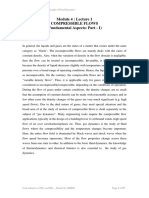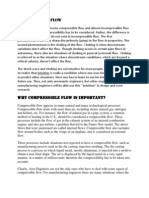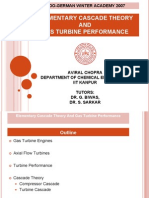Turbomach
Turbomach
Uploaded by
Thosh SanCopyright:
Available Formats
Turbomach
Turbomach
Uploaded by
Thosh SanOriginal Description:
Original Title
Copyright
Available Formats
Share this document
Did you find this document useful?
Is this content inappropriate?
Copyright:
Available Formats
Turbomach
Turbomach
Uploaded by
Thosh SanCopyright:
Available Formats
Turbomachinery Lecture Notes
2007-09-01
Review of Basic Laws of Turbomachinery
Damian Vogt Course MJ2429
Nomenclature
Symbol A E F I M Q W c g h p r t u w z Denotation Surface area Internal energy Force Rothalpy Moment Heat energy Mechanical energy Absolute velocity Gravitational constant Enthalpy Mass flow rate Pressure Radius Time Tangential velocity Relative velocity Height coordinate Density Rotational speed Unit m2 J N J/kg Nm J J m/s m/s2 J/kg kg/s Pa m s m/s m/s m kg/m3 rad/s
& m
Subscripts
0 1 2 3 c n R w X
Total Inlet stator Outlet stator (inlet rotor) Outlet rotor Total in absolute frame of reference Normal Radial component Total in relative frame of reference Axial component Tangential component
KTH/EKV/DV
Turbomachinery Lecture Notes
2007-09-01
Turbomachine System Discretization
Turbine shown
& Q
1 Schematic representation 1 2 inlet outlet
& W
A turbomachine consists of one or several stages
stator
rotor
1 Stage denotations 1 2 3 stator inlet rotor inlet rotor outlet
The thermodynamic and kinetic properties in a stage are defined by velocities
20 10
stator
rotor w3 u
30
u c3
Stage velocity triangles
c1
10
20
20
w2
30
10
10
u c2
20
30
KTH/EKV/DV
Turbomachinery Lecture Notes
2007-09-01
Conservation of Mass
Sum of mass flow rates over all system boundaries equals to change in mass in control volume
& m =
i
m t
m = 0 thus t
Eq. 1
For steady process
mass in control volume constant over time
& m = 0
i
Eq. 2
Mass flow rate through boundary
& m = cn A
Conservation of mass for control volume featuring one in- and one outflow
Eq. 3
1c n ,1 A1 = 2 c n , 2 A2
Eq. 4
Note: The indexes 1 and 2 refer to inlet and outlet of the control volume respectively as depicted below
Control volume e.g.: stage
KTH/EKV/DV
Turbomachinery Lecture Notes
2007-09-01
Conservation of Energy
First law of thermodynamics applied to closed process, i.e. system taken through a complete cycle
(dQ dW ) = 0
Change in internal energy during change in state from one point to another in the cycle
Eq. 5
dE = dQ dW
Eq. 6
For a steady flow process the conservation of energy per unit time is regarded, i.e. conservation of power
& & & & dE = m ( dh0 + g dz ) = Q W
Eq. 7
Where dh0 denotes the change in total enthalpy and the term g dz change in specific potential energy. Apart from hydraulic machines the latter can be neglected. Furthermore the process can be assumed as adiabatic leading to the conservation of energy for a steady turbomachine process being written as
& & W = m ( h01 h02 )
Note: work producing machines (turbines) work absorbing machines (compressors, pumps)
Eq. 8
& h01 > h02 W > 0 & h01 < h02 W < 0
KTH/EKV/DV
Turbomachinery Lecture Notes
2007-09-01
Conservation of Momentum
According to Newtons second law of motion the sum of all forces acing on a body equals the change in momentum
(mc x ) t
Eq. 9
For a steady flow process the change in momentum is exclusively due to the change in flow velocity
F
Note:
& = m (c x1 c x 2 )
Eq. 10
From the perspective of the fluid the forces are acting as pressure forces ( F = p A ). A change in velocity indicates a change in pressure remember Bernoullis equation for incompressible fluids: p 0 = p +
1 c 2 = const . 2
From the perspective of the turbomachine the pressure forces on the fluid are yielding a resultant reaction force (actio=reactio).
In a turbomachine the moment of momentum rather than the momentum itself is of interest
= r F =
(rmc ) t
Eq. 11
For a steady flow process the change in moment of momentum is due to the change in tangential flow velocity
& = m (r1c 1 r2 c 2 )
Eq. 12
KTH/EKV/DV
Turbomachinery Lecture Notes
2007-09-01
Eulers Turbine Equation
At this point the conservation of energy and the conservation of moment of momentum shall be combined. The mechanical work per unit time ( power) equals the product of moment and rotational speed
& W = M z
Eq. 13
Thus the conservation of energy can be related to the conservation of momentum as follows
& & m (h01 h02 ) = m (r1c 1 r2 c 2 )
Substituting
Eq. 14
& r by the tangential speed u and eliminating m yields
h01 h02 = u1c 1 u 2 c 2
Eq. 15
The above equation is referred to as Eulers turbine equation. Note: A change in total enthalpy is equivalent to a change in tangential flow speed and/or tangential engine speed For engines with little change in mean radius u1 u 2 (e.g. axial turbines, axial compressors, fans) the change in total enthalpy is entirely due to change in tangential flow speed h0 u c blades are bowed For engines with large change in mean radius (e.g. radial engines) the change in enthalpy is to a large degree due to the change in radius h0 u c centrifugal effect, possibility for larger change in enthalpy
Leonhard Euler Leonhard Euler (1707-1783) was arguably the greatest mathematician of the eighteenth century and one of the most prolific of all time; his publication list of 886 papers and books fill about 90 volumes. Remarkably, much of this output dates from the the last two decades of his life, when he was totally blind. Though born and educated in Basel, Switzerland, Euler spent most of his career in St. Petersburg and Berlin. He joined the St. Petersburg Academy of Sciences in 1727. In 1741 he went to Berlin at the invitation of Frederick the Great, but he and Frederick never got on well and in 1766 he returned to St. Petersburg, where he remained until his death. Euler's prolific output caused a tremendous problem of backlog: the St. Petersburg Academy continued publishing his work posthumously for more than 30 years. Euler married twice and had 13 children, though all but five of them died young.
KTH/EKV/DV
Turbomachinery Lecture Notes
2007-09-01
Rothalpy
Reformulating Eulers turbine equation leads to a fundamental aspect of turbomachine thermodynamics referred to as rothalpy
h01 u1c 1 = h02 u 2 c 2 = I
The rothalpy is a function that remains constant throughout a rotating machine. Note: in a non-rotating machine the total enthalpy is constant (non-rotating equation) The general notation of rothalpy is
Eq. 16
u = 0 in the above
I =h+
1 2 c u c 2
Eq. 17
This expression can be reformulated by expressing the velocities in the relative frame of reference as follows
c w u C cx
c u = w c = w + u
Eq. 18 Eq. 19
c 2 = c x + c = c x + w + 2w u + u 2
2 2 2 2
Substituting c
and c in the expression of rothalpy
I =h+
1 2 1 2 u2 2 2 c x + w + 2 w u + u 2 w u u 2 = h + c x + w 2 2 2
Eq. 20
With c x = w x and
w 2 = wx + w the reformulated expression of the rothalpy yields 1 1 I = h + w2 u 2 2 2
2 2
Eq. 21
KTH/EKV/DV
You might also like
- Turbomachinery and Propulsion MECH 6171Document26 pagesTurbomachinery and Propulsion MECH 6171md arifNo ratings yet
- Modeling Frequency Dependency of Gas Turbine OutputDocument6 pagesModeling Frequency Dependency of Gas Turbine OutputDiego CarpioNo ratings yet
- Compressible Fluid Flow CFF Module 4Document57 pagesCompressible Fluid Flow CFF Module 4Jasim RasheedNo ratings yet
- Analytical Determination of Radial Inflow Turbine Design Geometry For Maximum Efficiency by RohlikDocument39 pagesAnalytical Determination of Radial Inflow Turbine Design Geometry For Maximum Efficiency by RohlikSyed Jiaul HoqueNo ratings yet
- 16-Hydraulic Turbines (Compatibility Mode)Document70 pages16-Hydraulic Turbines (Compatibility Mode)Rachit ParikhNo ratings yet
- Compressor DesignDocument34 pagesCompressor Designramamurthy123No ratings yet
- 06-PT11-Axial Flow Compressors (Compatibility Mode)Document85 pages06-PT11-Axial Flow Compressors (Compatibility Mode)Ashok Kumar Yalamanchili100% (1)
- AP-1 - Unit-IV: Rotating Machinery-Axial Flow Compressors, Axial Flow TurbinesDocument39 pagesAP-1 - Unit-IV: Rotating Machinery-Axial Flow Compressors, Axial Flow TurbinessushmarajagopalNo ratings yet
- Thermodynamics 1Document40 pagesThermodynamics 1Krishna Kumar G100% (1)
- Performance of Industrial GasturbinesDocument28 pagesPerformance of Industrial Gasturbinessomporn duangbuntaoNo ratings yet
- Heat Transfer LecturesDocument200 pagesHeat Transfer LecturesdnkindrajithNo ratings yet
- Optimization of Turbo Machinery Validation Against Experimental ResultsDocument13 pagesOptimization of Turbo Machinery Validation Against Experimental ResultsSrinivasNo ratings yet
- L4-Gas Turbine Systems SSRDocument18 pagesL4-Gas Turbine Systems SSRTarun Malviya100% (1)
- Aerodynamics Propulsion Systems JCI 031114Document52 pagesAerodynamics Propulsion Systems JCI 031114Joseph O. Camacho IrizarryNo ratings yet
- Fluid Mechanics - II: Analysis of Compressible FlowDocument29 pagesFluid Mechanics - II: Analysis of Compressible FlowAkmal BhattiNo ratings yet
- 05 PT12 AxComp 3 65 (Compatibility Mode)Document65 pages05 PT12 AxComp 3 65 (Compatibility Mode)Sailesh_Slayer100% (1)
- Estimation of Turbomachinery Losses Through Cascade TestingDocument54 pagesEstimation of Turbomachinery Losses Through Cascade Testingchandrasingh4564No ratings yet
- Gas Turbine Governing Dynamics and Control SystemsDocument40 pagesGas Turbine Governing Dynamics and Control SystemsAmlan Chowdhury100% (1)
- ME6604-Gas Dynamics and Jet PropulsionDocument116 pagesME6604-Gas Dynamics and Jet PropulsionMohanraj Subramani0% (1)
- Material Science Fatigue and CreepDocument15 pagesMaterial Science Fatigue and CreepPrakash KatdareNo ratings yet
- E-Notes PDF All-Units 20052019032653PM PDFDocument227 pagesE-Notes PDF All-Units 20052019032653PM PDFEr Samkit ShahNo ratings yet
- APD Dynamic StressesDocument11 pagesAPD Dynamic StressesadehriyaNo ratings yet
- Moving Normal ShockwaveDocument10 pagesMoving Normal ShockwaveWaqas Shamraiz50% (2)
- Thermo PDFDocument129 pagesThermo PDFbansallove2008No ratings yet
- 12-Combustors (Compatibility Mode)Document42 pages12-Combustors (Compatibility Mode)Fanimation- ファニメーション100% (1)
- Binder CreepDocument29 pagesBinder CreepettypasewangNo ratings yet
- ME346A Lecture Notes Win2012Document183 pagesME346A Lecture Notes Win2012Moises RomeroNo ratings yet
- AerodynamicsDocument284 pagesAerodynamicsCaptRavi PooniaNo ratings yet
- TITLE: Flow Characteristic Through The Convergent-Divergent DuctDocument7 pagesTITLE: Flow Characteristic Through The Convergent-Divergent DuctrazermabiokiNo ratings yet
- Handbook of Supersonic AerodynamicsDocument229 pagesHandbook of Supersonic Aerodynamicsefrain diazNo ratings yet
- Enhancing Energy Efficiency Thru CogenerationDocument17 pagesEnhancing Energy Efficiency Thru CogenerationDeepika Mishra100% (1)
- Fundamental Concepts of Real Gas DynamicsDocument114 pagesFundamental Concepts of Real Gas Dynamicsgimmyhead_69No ratings yet
- Chapter 3 Laplace TransformDocument77 pagesChapter 3 Laplace TransformafiqNo ratings yet
- Compressor Modeling With Inlet DistortionDocument25 pagesCompressor Modeling With Inlet Distortionsainath_84No ratings yet
- AeroEngineTech 5 FransLoekito 4776887Document5 pagesAeroEngineTech 5 FransLoekito 4776887Frans LoekitoNo ratings yet
- 13-Steam Turbines (Compatibility Mode)Document50 pages13-Steam Turbines (Compatibility Mode)Chintan RavalNo ratings yet
- Compressible FlowDocument11 pagesCompressible FlowZain Abdul Malik NooraliNo ratings yet
- AIAA2000 2234 Flow Control in Gas TurbinesDocument16 pagesAIAA2000 2234 Flow Control in Gas TurbinesErico Antonio TeixeiraNo ratings yet
- AnalysisMethods SSR SSCI SSTIDocument27 pagesAnalysisMethods SSR SSCI SSTIRaturi DeepankarNo ratings yet
- 7 - Axial Flow TurbineDocument43 pages7 - Axial Flow TurbineAmechNo ratings yet
- Combustion Dynamics Application of Active InstabilDocument17 pagesCombustion Dynamics Application of Active InstabilEduardoNo ratings yet
- Centrifugal CompressorDocument20 pagesCentrifugal CompressorMir Aqueel AliNo ratings yet
- Ekc212 Notes PDFDocument78 pagesEkc212 Notes PDFHelan DarshNo ratings yet
- Nuclear Power Plant Steam Turbine-Modeling For Model Based Control PurposesDocument25 pagesNuclear Power Plant Steam Turbine-Modeling For Model Based Control PurposesMuhammad Junaid DarNo ratings yet
- Cascades Tunnel: P KarthikeyanDocument18 pagesCascades Tunnel: P KarthikeyanMohammed VaseemNo ratings yet
- Radial-Inflow Turbines: Vavra, M. HDocument65 pagesRadial-Inflow Turbines: Vavra, M. HSiraj MohammedNo ratings yet
- Me1303-Gas Dynamics and Jet Propulsion PDFDocument58 pagesMe1303-Gas Dynamics and Jet Propulsion PDFNarayana SamyNo ratings yet
- Inviscid Fluid DynamicsDocument101 pagesInviscid Fluid DynamicsMessy UzunovNo ratings yet
- Heat and Mass Transfer Heat Transfer For PDFDocument7 pagesHeat and Mass Transfer Heat Transfer For PDFEinar TverangerNo ratings yet
- Design of Robotic Dexterous HandDocument31 pagesDesign of Robotic Dexterous HandAlfonso CruzNo ratings yet
- Air Breathing Propulsion Unit-3Document22 pagesAir Breathing Propulsion Unit-3api-271354682No ratings yet
- Averaging Nonuniform Flow For A PurposeDocument10 pagesAveraging Nonuniform Flow For A PurposeAli Al-hamalyNo ratings yet
- COMSOL Workshop PDFDocument23 pagesCOMSOL Workshop PDFحيدر ممتاز حسين الشاميNo ratings yet
- Elementary Cascade Theory AND Gas Turbine Performance: Indo-German Winter Academy 2007Document37 pagesElementary Cascade Theory AND Gas Turbine Performance: Indo-German Winter Academy 2007omprakashsingh123No ratings yet
- Pump Notes PDFDocument25 pagesPump Notes PDFUsman KhalidNo ratings yet
- Turbo MachinesDocument254 pagesTurbo Machinesyash_ganatra0% (1)
- DSMC Simulations of Rarefied Flow Over A Square CylinderDocument8 pagesDSMC Simulations of Rarefied Flow Over A Square CylinderThosh SanNo ratings yet
- Polyglossia: A Babel Replacement For XƎL Tex and Lual Tex: A A F C Current Maintainer: A RDocument15 pagesPolyglossia: A Babel Replacement For XƎL Tex and Lual Tex: A A F C Current Maintainer: A RThosh SanNo ratings yet
- Ijms 12 03263 PDFDocument25 pagesIjms 12 03263 PDFThosh SanNo ratings yet
- Working Professionals in R & D Organization and IndustryDocument4 pagesWorking Professionals in R & D Organization and IndustryThosh SanNo ratings yet
- Gpu Computing. Graphics Processing Units (Gpus) Are High-Performance Many-Core ProcessorsDocument2 pagesGpu Computing. Graphics Processing Units (Gpus) Are High-Performance Many-Core ProcessorsThosh SanNo ratings yet
































































